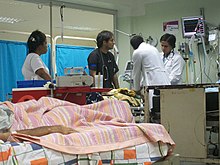
Back حيوية معلقة Arabic Anabioz Azerbaijani Анабіёз Byelorussian Анабиоза Bulgarian Ŝajnmorto Esperanto Animación suspendida Spanish زیست تعویقی Persian Biostase French Hibernáció Hungarian Անաբիոզ Armenian
This article may require cleanup to meet Wikipedia's quality standards. The specific problem is: the article has problems with clarity, grammar, spacing, punctuation and tone. (June 2017) |

Suspended animation is the temporary (short- or long-term) slowing or stopping of biological function so that physiological capabilities are preserved. States of suspended animation are common in micro-organisms and some plant tissue, such as seeds. Many animals, including large ones, may undergo hibernation, and most plants have periods of dormancy. This article focuses primarily on the potential of large animals, especially humans, to undergo suspended animation.
In animals, suspended animation may be either hypometabolic or ametabolic in nature. It may be induced by either endogenous, natural or artificial biological, chemical or physical means. In its natural form, it may be spontaneously reversible as in the case of species demonstrating hypometabolic states of hibernation. When applied with therapeutic intent, as in deep hypothermic circulatory arrest (DHCA), usually technologically mediated revival is required.[1][2]
- ^ "Suspended Animation". Medical-Dictionary.thefreedictionary.com.
- ^ Asfar, P; Calzia, E; Radermacher, P (2014). "Is pharmacological, H2S-induced 'suspended animation' feasible in the ICU?". Crit Care. 18 (2): 215. doi:10.1186/cc13782. PMC 4060059. PMID 25028804.